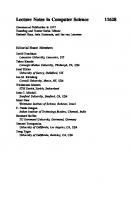Databases theory and applications, 31 Australasian Database Conf., ADC 2020 9783030394684, 9783030394691
159 84 5MB
English Pages 250 Year 2020
Table of contents :
Preface......Page 6
General Chair’s Welcome Message......Page 7
Organization......Page 8
Contents......Page 10
Full Research Papers......Page 12
1 Introduction......Page 13
2 Motivation......Page 14
3 Proposed Approach......Page 15
3.1 Scenario......Page 16
4 RNL Specification to DL ALCQI Representation......Page 18
5 DL ALCQI Representation to SQL Script......Page 20
6 Conceptual Model Generation......Page 21
8 DL ALCQI Representation to RNL verbalisation......Page 22
10 Conclusion......Page 23
References......Page 24
1 Introduction......Page 26
3 Methodology......Page 29
3.2 Preliminaries......Page 30
3.4 Visual Feature Encoder......Page 31
4.1 Experimental Settings......Page 32
4.2 Quantitative Analysis......Page 33
4.3 Qualitative Analysis......Page 34
4.5 Model Structure Comparison......Page 35
References......Page 36
1 Introduction......Page 39
2.1 kNN Queries......Page 41
3 Preliminary......Page 42
4.1 Dijkstra AkNN......Page 44
4.2 Grid-Based AkNN......Page 45
5.2 Case Study......Page 47
5.3 Different Indexes......Page 48
5.4 AkNN Search Algorithms......Page 49
References......Page 50
1 Introduction......Page 52
2 Motivating Example......Page 53
3 Preliminaries......Page 55
4.1 Model Construction......Page 56
4.2 Extract Model Traces......Page 59
5 Case Study......Page 60
6 Related Work and Discussion......Page 62
7 Conclusion......Page 63
References......Page 64
1 Introduction......Page 65
2.1 Data Streams......Page 67
3 Problem Definition......Page 68
3.2 Confidence Score of Recovery......Page 69
4 Backup Selection for Approximate Fault Tolerance......Page 70
4.1 Upper Bounds Derivation for Variance of Sensors......Page 71
4.2 Greedy-Based Backup Selection......Page 73
5.1 Experimental Settings......Page 74
5.2 Experimental Results......Page 75
6 Conclusion......Page 76
References......Page 77
1 Introduction......Page 78
2 Related Work......Page 79
3.1 Range Indexes as Cumulative Distribution Functions......Page 80
3.2 Polynomial Interpolation......Page 81
4.1 Interpolant Construction......Page 83
4.2 Query Processing......Page 84
5.1 Model Creation Time......Page 85
5.2 Memory Footprint......Page 86
5.3 Query Accuracy and Time......Page 87
5.4 Rate of Convergence of Polynomial Models......Page 88
References......Page 89
1 Introduction......Page 91
2.2 Friendship Prediction......Page 93
3 Problem Formulation......Page 94
4 Design of DEFINE......Page 95
5.2 Prediction......Page 98
6 Conclusion......Page 100
References......Page 101
1 Introduction......Page 103
2 Related Work......Page 105
3.2 Problem Formulation......Page 106
3.3 Dual-Branch Graph Convolutional Network Hashing......Page 107
3.4 Objective Function......Page 108
4 Experiments......Page 109
4.2 Experiment Settings......Page 110
4.3 Implementation Details......Page 111
4.4 Experiment Results and Analysis......Page 112
References......Page 113
1 Introduction......Page 115
2.1 Shortest Path Algorithm......Page 117
2.2 Graph Similarity Measurement......Page 118
3 Problem Definition......Page 119
4.2 Non-uniform Sampling......Page 120
5.1 Edge-Based Representation......Page 121
5.2 Vertex-Based Representation......Page 123
5.3 Graph Clustering and Snapshot Matching......Page 124
6.1 Experimental Setup......Page 125
6.2 Typical Snapshot Selection......Page 126
6.3 Snapshot Matching......Page 127
References......Page 128
1 Introduction......Page 131
2.1 Problem Definition......Page 132
2.2 Related Work......Page 133
3.1 Similarity Model......Page 134
3.2 State-Transition Model......Page 135
3.3 Candidate-Evolving Model......Page 137
4.1 Experimental Settings......Page 138
4.2 Data Quality Challenges......Page 139
References......Page 141
1 Introduction......Page 144
2 Related Work......Page 145
3.1 Notations and Problem Definition......Page 146
3.3 Node Attribute Encoding......Page 147
3.4 Graph Structure Encoding......Page 148
3.6 Complexity Analysis......Page 150
4.2 Compared Algorithms and Setup......Page 151
4.3 Link Prediction......Page 152
4.4 Multi-class Node Classification......Page 153
4.6 Scalability......Page 154
5 Conclusion......Page 155
References......Page 156
1 Introduction......Page 157
2 Related Work......Page 158
3.1 Problem Definition......Page 159
4.1 Social-First Based Approach......Page 161
4.3 Hybrid Approach......Page 162
5.1 Experimental Setup......Page 166
5.2 Performance Evaluation......Page 167
5.3 Conclusions......Page 169
References......Page 170
1 Introduction......Page 171
3 Problem Definition......Page 173
4.2 Comparisons of Users......Page 174
4.4 Combination of Social Networks......Page 175
5.1 Cores Decomposition......Page 176
5.2 Index Construction......Page 177
6 Cost Analysis......Page 178
7.2 Evaluation Methodology......Page 179
7.4 Efficiency Comparison......Page 180
References......Page 181
1 Introduction......Page 183
3 The 2ED Algorithm......Page 184
3.1 Features of the 2ED Algorithm......Page 185
4 Improvement on 2ED......Page 186
4.2 Using Language Models......Page 188
4.3 Estimating Word Similarity......Page 189
5.2 Rescore Candiadte Pairs......Page 190
6 Experimental Studies......Page 191
7 Conclusion and Future Work......Page 193
References......Page 194
Short Papers......Page 196
1 Introduction......Page 197
2.1 Fashion Compatibility Learning......Page 198
2.2 Graph Neural Networks......Page 199
3.2 Part 1: Item Representation Generation......Page 200
3.3 Part 2: Type-Aware Compatibility Prediction......Page 201
4.1 Dataset......Page 202
4.4 Task Description......Page 203
References......Page 204
1 Introduction......Page 206
2.2 Popularity and Fitness-Based Service Evolving Networks......Page 208
3 Analysis and Results......Page 210
4 Conclusion and Future Work......Page 212
References......Page 213
1 Introduction......Page 214
3 Preliminary and Problem Definition......Page 215
4 AIC Detection Algorithm......Page 217
4.2 Improved Greedy Algorithm......Page 218
5 Experiment and Result......Page 219
5.1 Efficiency......Page 220
5.2 Community Quality Evaluation......Page 221
References......Page 222
1 Introduction......Page 224
2.1 Candidate Words Extraction......Page 225
2.2 Contextual Semantic-Based Graph Construction......Page 226
2.3 Words Ranking and Lexicon Expansion......Page 227
3.1 Dataset and Embedding Learning......Page 228
3.2 Evaluation Results......Page 229
3.3 Comparative Analysis......Page 230
References......Page 231
1 Introduction......Page 233
2.1 Thermal Power Plant Regenerative System......Page 234
2.2 High-Pressure Feedwater Heater Group......Page 235
3 Data-Driven Hierarchical Neural Network Modeling......Page 236
3.1 Architecture of the Proposed Model......Page 237
4.3 Experimental Setting and Results......Page 238
References......Page 240
1 Introduction......Page 242
2 Literature Review......Page 243
3 Research Challenges......Page 244
4 Contribution to Knowledge......Page 245
4.1 Analysis of Diabetic Eye Disease Using Deep Learning......Page 246
References......Page 248
Author Index......Page 250
Preface......Page 6
General Chair’s Welcome Message......Page 7
Organization......Page 8
Contents......Page 10
Full Research Papers......Page 12
1 Introduction......Page 13
2 Motivation......Page 14
3 Proposed Approach......Page 15
3.1 Scenario......Page 16
4 RNL Specification to DL ALCQI Representation......Page 18
5 DL ALCQI Representation to SQL Script......Page 20
6 Conceptual Model Generation......Page 21
8 DL ALCQI Representation to RNL verbalisation......Page 22
10 Conclusion......Page 23
References......Page 24
1 Introduction......Page 26
3 Methodology......Page 29
3.2 Preliminaries......Page 30
3.4 Visual Feature Encoder......Page 31
4.1 Experimental Settings......Page 32
4.2 Quantitative Analysis......Page 33
4.3 Qualitative Analysis......Page 34
4.5 Model Structure Comparison......Page 35
References......Page 36
1 Introduction......Page 39
2.1 kNN Queries......Page 41
3 Preliminary......Page 42
4.1 Dijkstra AkNN......Page 44
4.2 Grid-Based AkNN......Page 45
5.2 Case Study......Page 47
5.3 Different Indexes......Page 48
5.4 AkNN Search Algorithms......Page 49
References......Page 50
1 Introduction......Page 52
2 Motivating Example......Page 53
3 Preliminaries......Page 55
4.1 Model Construction......Page 56
4.2 Extract Model Traces......Page 59
5 Case Study......Page 60
6 Related Work and Discussion......Page 62
7 Conclusion......Page 63
References......Page 64
1 Introduction......Page 65
2.1 Data Streams......Page 67
3 Problem Definition......Page 68
3.2 Confidence Score of Recovery......Page 69
4 Backup Selection for Approximate Fault Tolerance......Page 70
4.1 Upper Bounds Derivation for Variance of Sensors......Page 71
4.2 Greedy-Based Backup Selection......Page 73
5.1 Experimental Settings......Page 74
5.2 Experimental Results......Page 75
6 Conclusion......Page 76
References......Page 77
1 Introduction......Page 78
2 Related Work......Page 79
3.1 Range Indexes as Cumulative Distribution Functions......Page 80
3.2 Polynomial Interpolation......Page 81
4.1 Interpolant Construction......Page 83
4.2 Query Processing......Page 84
5.1 Model Creation Time......Page 85
5.2 Memory Footprint......Page 86
5.3 Query Accuracy and Time......Page 87
5.4 Rate of Convergence of Polynomial Models......Page 88
References......Page 89
1 Introduction......Page 91
2.2 Friendship Prediction......Page 93
3 Problem Formulation......Page 94
4 Design of DEFINE......Page 95
5.2 Prediction......Page 98
6 Conclusion......Page 100
References......Page 101
1 Introduction......Page 103
2 Related Work......Page 105
3.2 Problem Formulation......Page 106
3.3 Dual-Branch Graph Convolutional Network Hashing......Page 107
3.4 Objective Function......Page 108
4 Experiments......Page 109
4.2 Experiment Settings......Page 110
4.3 Implementation Details......Page 111
4.4 Experiment Results and Analysis......Page 112
References......Page 113
1 Introduction......Page 115
2.1 Shortest Path Algorithm......Page 117
2.2 Graph Similarity Measurement......Page 118
3 Problem Definition......Page 119
4.2 Non-uniform Sampling......Page 120
5.1 Edge-Based Representation......Page 121
5.2 Vertex-Based Representation......Page 123
5.3 Graph Clustering and Snapshot Matching......Page 124
6.1 Experimental Setup......Page 125
6.2 Typical Snapshot Selection......Page 126
6.3 Snapshot Matching......Page 127
References......Page 128
1 Introduction......Page 131
2.1 Problem Definition......Page 132
2.2 Related Work......Page 133
3.1 Similarity Model......Page 134
3.2 State-Transition Model......Page 135
3.3 Candidate-Evolving Model......Page 137
4.1 Experimental Settings......Page 138
4.2 Data Quality Challenges......Page 139
References......Page 141
1 Introduction......Page 144
2 Related Work......Page 145
3.1 Notations and Problem Definition......Page 146
3.3 Node Attribute Encoding......Page 147
3.4 Graph Structure Encoding......Page 148
3.6 Complexity Analysis......Page 150
4.2 Compared Algorithms and Setup......Page 151
4.3 Link Prediction......Page 152
4.4 Multi-class Node Classification......Page 153
4.6 Scalability......Page 154
5 Conclusion......Page 155
References......Page 156
1 Introduction......Page 157
2 Related Work......Page 158
3.1 Problem Definition......Page 159
4.1 Social-First Based Approach......Page 161
4.3 Hybrid Approach......Page 162
5.1 Experimental Setup......Page 166
5.2 Performance Evaluation......Page 167
5.3 Conclusions......Page 169
References......Page 170
1 Introduction......Page 171
3 Problem Definition......Page 173
4.2 Comparisons of Users......Page 174
4.4 Combination of Social Networks......Page 175
5.1 Cores Decomposition......Page 176
5.2 Index Construction......Page 177
6 Cost Analysis......Page 178
7.2 Evaluation Methodology......Page 179
7.4 Efficiency Comparison......Page 180
References......Page 181
1 Introduction......Page 183
3 The 2ED Algorithm......Page 184
3.1 Features of the 2ED Algorithm......Page 185
4 Improvement on 2ED......Page 186
4.2 Using Language Models......Page 188
4.3 Estimating Word Similarity......Page 189
5.2 Rescore Candiadte Pairs......Page 190
6 Experimental Studies......Page 191
7 Conclusion and Future Work......Page 193
References......Page 194
Short Papers......Page 196
1 Introduction......Page 197
2.1 Fashion Compatibility Learning......Page 198
2.2 Graph Neural Networks......Page 199
3.2 Part 1: Item Representation Generation......Page 200
3.3 Part 2: Type-Aware Compatibility Prediction......Page 201
4.1 Dataset......Page 202
4.4 Task Description......Page 203
References......Page 204
1 Introduction......Page 206
2.2 Popularity and Fitness-Based Service Evolving Networks......Page 208
3 Analysis and Results......Page 210
4 Conclusion and Future Work......Page 212
References......Page 213
1 Introduction......Page 214
3 Preliminary and Problem Definition......Page 215
4 AIC Detection Algorithm......Page 217
4.2 Improved Greedy Algorithm......Page 218
5 Experiment and Result......Page 219
5.1 Efficiency......Page 220
5.2 Community Quality Evaluation......Page 221
References......Page 222
1 Introduction......Page 224
2.1 Candidate Words Extraction......Page 225
2.2 Contextual Semantic-Based Graph Construction......Page 226
2.3 Words Ranking and Lexicon Expansion......Page 227
3.1 Dataset and Embedding Learning......Page 228
3.2 Evaluation Results......Page 229
3.3 Comparative Analysis......Page 230
References......Page 231
1 Introduction......Page 233
2.1 Thermal Power Plant Regenerative System......Page 234
2.2 High-Pressure Feedwater Heater Group......Page 235
3 Data-Driven Hierarchical Neural Network Modeling......Page 236
3.1 Architecture of the Proposed Model......Page 237
4.3 Experimental Setting and Results......Page 238
References......Page 240
1 Introduction......Page 242
2 Literature Review......Page 243
3 Research Challenges......Page 244
4 Contribution to Knowledge......Page 245
4.1 Analysis of Diabetic Eye Disease Using Deep Learning......Page 246
References......Page 248
Author Index......Page 250






![Database Design and Modeling with PostgreSQL and MySQL: Build efficient and scalable databases for modern applications using open source databases [1 ed.]
9781803233475, 9781804611456, 9781803248349](https://ebin.pub/img/200x200/database-design-and-modeling-with-postgresql-and-mysql-build-efficient-and-scalable-databases-for-modern-applications-using-open-source-databases-1nbsped-9781803233475-9781804611456-9781803248349.jpg)



![Linear Algebra, Theory And Applications [May 4, 2020 ed.]](https://ebin.pub/img/200x200/linear-algebra-theory-and-applications-may-4-2020nbsped.jpg)